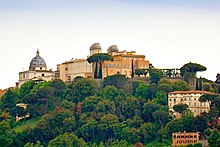Papal Palace Of Castel Gandolfo

History

The Vatican acquired the castle in 1596, in payment of a debt owed by the Savelli family. It dated from the 13th century.
The gardens occupy the site of a residence of the Roman Emperor Domitian. The palace was designed by Swiss-Italian architect Carlo Maderno for Pope Urban VIII. Since then, about half of his successors have used the properties as a summer residence and vacation retreat, except for the years between 1870 and 1929 when the popes, in dispute with Italy over territorial claims, did not leave Vatican City. Pope Pius XI had the facilities modernized and began using the retreat again in 1934. In accordance with the Lateran Treaty of 1929, the palace and the adjoining Villa Barberini added to the complex by Pope Pius XI are extraterritorial properties of the Holy See.
During World War II, an unknown number of Jewish refugees took shelter at the palace under the protection of the Holy See and many people used the site as a refuge from Allied bombing raids in 1944, though more than 500 people died in one such attack. Pope Pius XII died at the palace in 1958, as did Pope Paul VI in 1978. Pope John Paul II had a swimming pool built at the palace, which was criticized by some. Paparazzi used the opportunity to take photos of him.
Pope Benedict XVI flew to the palace at the conclusion of his papacy on 28 February 2013, was joined by Pope Francis for lunch on 23 March, and returned to Vatican City on 2 May. Francis visited the property twice more, but has never stayed overnight. In June 2013, Francis announced he would not spend the summer in Castel Gandolfo as many of his predecessors had, but would lead the Angelus there on 14 July. In retirement, Benedict used it at Francis' invitation for a two-week vacation in 2015.
On 7 December 2013, Pope Francis named Osvaldo Gianoli as the Director of the Pontifical Villas of Castel Gandolfo. In March 2014, the Vatican opened the Barberini Gardens to paid visitors on escorted tours during morning hours every day but Sunday. Beginning 11 September 2015, the public was able to travel from Vatican City to Castel Gandolfo by a train that had previously been reserved for use by the pope. Before the end of the year, products from the farm, previously only available to Vatican employees, were made available for purchase by the public.
On 21 October 2016, the palace was opened to the public for viewing without undergoing any structural changes. When asked if the building would again become a papal apartment, Castel Gandolfo mayor Milvia Monachesi said: "the fact that the palace is now a museum will make a reversal in the future difficult".

Legal status
Pursuant to the Lateran Treaty of 1929, the Papal Palace of Castel Gandolfo is Italian territory, but owned by the Holy See and equipped with extraterritoriality comparable to that of diplomatic missions. It is exempt from Italian taxes and expropriations, and Italian authorities are prohibited from entering it without the consent of the Holy See.
See also
References
- ^ Squires, Nick (23 February 2013). "A rare glimpse inside the remote retreat Pope Benedict XVI is soon to call home". The Telegraph.
- ^ Johnson, Alan (23 March 2013). "Pope Francis visits Benedict XVI at Castel Gandolfo". BBC. Retrieved 3 March 2014.
- ^ Wooden, Cindy (6 June 2013). "Pope Francis decides not to spend summer at Castel Gandolfo". National Catholic Reporter. Catholic News Service. Retrieved 9 May 2019.
According to Saverio Petrillo, director of the villa, about half the popes since then have followed Pope Urban's lead. Over the centuries, war, political turmoil, illness and just plain not liking the setting accounted for some pontiffs renouncing use of the villa, Petrillo wrote.
- ^ Schlott, René (28 February 2013). "Castel Gandolfo: The Colorful History of the Pope's Summer Home". Spiegel International. Retrieved 3 March 2014.
- ^ Cortesi, Arnaldo (9 October 1958). "Pontiff 19 Years" (PDF). New York Times. Retrieved 3 March 2014.
- ^ Tanner, Henry (7 August 1978). "Election to be Held" (PDF). New York Times. Retrieved 3 March 2014.
- ^ "Castel Gandolfo: The Colorful History of the Pope's Summer Home". Spiegel.de. Retrieved 19 January 2017.
- ^ Donadio, Rachel (28 February 2013). "Discord Remains at Vatican as Pope Benedict Departs". New York Times. Retrieved 3 March 2014.
- ^ Povoledo, Elisabetta (2 May 2013). "With Benedict's Return, Vatican Experiment Begins". New York Times. Retrieved 3 March 2014.
- ^ Hancock, Edith (28 October 2016). "Inside Pope Francis' summer home, which has just been opened to the public". Business Insider. Retrieved 9 May 2019.
- ^ Harris, Elise (30 June 2015). "Francis wishes Benedict XVI a good summer in Castel Gandolfo". Catholic News Agency. Retrieved 9 May 2019.
- ^ "Nomina del Direttore delle Ville Pontificie di Castelgandolfo" (Press release). Holy See Press Office. 7 December 2013. Retrieved 3 March 2014.
- ^ "Bergoglio opens Castel Gandolfo gardens to the public". Vatican Insider. 3 March 2014. Retrieved 3 March 2014.
- ^ Cousturie, Isabelle (24 October 2016). "Pope Francis gives up papal summer residence at Castel Gandolfo". Aleteia. Retrieved 9 May 2019.
- ^ Marchetti, Silvia (16 January 2018). "God's Grocer: Pope Francis Has Opened His Farm to Visitors". Newsweek. Retrieved 9 May 2019.
- ^ "Pope gives up another indulgence: His summer palace". Religion News Service. 21 October 2016. Retrieved 19 January 2017.
- ^ Pullella, Philip (21 October 2016). "Papal summer residence, shunned by Francis, opened to public". Reuters. Retrieved 19 January 2017.
- ^ Lateran Treaty, Article 15 and annex II.
- Additional sources
- Petrillo, Saverio (1995). I papi a Castel Gandolfo. Velletri: Edizioni Tra 8 & 9. OCLC 34817188.
- Graziano, Nisio (2008). Dalla leggendaria Alba Longa a Castel Gandolfo, Castel Gandolfo: Il Vecchio Focolare.